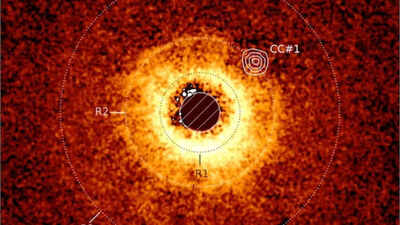The James Webb Space Telescope (JWST) has achieved a significant milestone by directly imaging its first new planet. This marks a pivotal moment after three years of the telescope aiding astronomers in the detailed study of known exoplanets. The newly discovered world, named TWA 7b, is remarkable for being the lowest-mass planet ever directly imaged outside our solar system.

Image: The James Webb Space Telescope captures its first exoplanet, TWA 7b.
TWA 7b has an estimated mass of only 0.3 times that of Jupiter, or approximately 100 times the mass of Earth. This makes it ten times lighter than any other exoplanet previously directly imaged.
The exoplanet orbits a young, low-mass star called CE Antliae (TWA 7), which resides roughly 111 light-years away in the Antlia constellation. CE Antliae, identified in 1999, belongs to the TW Hydrae Association, a stellar group recognized for its youthfulness. The star is estimated to be just 6.4 million years old, a cosmic infant compared to our Sun, which is 4.6 billion years old. Its youth and near pole-on orientation from Earth make it an ideal target for JWST's imaging capabilities.
The discovery of TWA 7b was made possible through infrared imaging. Young, low-mass planets like TWA 7b emit thermal radiation in the infrared spectrum, a specialty of JWST. The telescope's Mid-Infrared Instrument (MIRI), combined with a coronagraph, played a crucial role.
A coronagraph is designed to block the overwhelming light of a star, enabling the detection of faint, nearby objects such as exoplanets. By using high-contrast imaging techniques, the JWST team identified a faint infrared source embedded within the debris disc surrounding TWA 7.
This source was found within a gap between rings of dust – a region theorized to be formed by a planet's gravitational influence. Simulations confirmed that a planet with the mass of Saturn located in that precise location could account for the observed structure.
The disc surrounding TWA 7 consists of three distinct rings, separated by gaps. One of these gaps contains a narrow ring flanked by two dust-free regions, a telltale sign of the gravitational forces exerted by an orbiting planet. The infrared glow detected by JWST aligns perfectly with this ring gap. Its brightness, temperature (around 320 Kelvin or 47°C), and orbital distance (approximately 50 astronomical units from the star) all correspond with scientists' expectations for a planet in this region.
The discovery of TWA 7b is a milestone in exoplanet science for several key reasons:
Astronomers believe that the structures observed in debris discs around young stars provide a blueprint for planetary formation. These rings and gaps represent zones where material is either accumulating to form planets or being cleared out by their gravitational pull. TWA 7b may be the first direct evidence of this process in action.
The detection of TWA 7b required the use of advanced image subtraction methods. By removing residual starlight, researchers were able to isolate the planet from other celestial bodies and background galaxies. This demonstrates how new observing methods and instruments on JWST, such as the coronagraph and MIRI, are expanding our ability to discover previously inaccessible exoplanets. JWST's mid-infrared sensitivity allows it to detect planets as massive and as cold as Saturn, a substantial improvement in direct imaging.
JWST's capability to suppress starlight and detect the faint heat signatures of small, cold planets is opening new frontiers in exoplanet discovery. Astronomers are optimistic that even lighter planets, possibly Neptune-mass or even super-Earths, could soon be within reach.
Future follow-up observations will focus on:
Newer articles
Older articles
 Gavaskar Calls for Kuldeep Yadav's Inclusion in Second Test Amid Bumrah Fitness Concerns, Cites Edgbaston Spin Advantage
Gavaskar Calls for Kuldeep Yadav's Inclusion in Second Test Amid Bumrah Fitness Concerns, Cites Edgbaston Spin Advantage
 Indian Astronaut Shukla Arrives at ISS, Ushering in New Era for Space Program
OR
India Celebrates as Shukla Reaches ISS, Advancing Ambitious Space Goals
Indian Astronaut Shukla Arrives at ISS, Ushering in New Era for Space Program
OR
India Celebrates as Shukla Reaches ISS, Advancing Ambitious Space Goals
 Rishabh Pant Revolutionizing Cricket, Says Greg Chappell
Rishabh Pant Revolutionizing Cricket, Says Greg Chappell
 Toxic Workplace Warning Signs: Spot the Red Flags Early
Toxic Workplace Warning Signs: Spot the Red Flags Early
 Global Immunization Crisis: Millions of Children at Risk as Vaccine Coverage Lags, Study Reveals
Global Immunization Crisis: Millions of Children at Risk as Vaccine Coverage Lags, Study Reveals
 Indian Cricket Star Mukesh Kumar and Wife Divya Singh Announce the Arrival of Baby Boy
Indian Cricket Star Mukesh Kumar and Wife Divya Singh Announce the Arrival of Baby Boy
 Moto G54 Price Slashed in India: Check Out the Discounted Rates and Specs
Moto G54 Price Slashed in India: Check Out the Discounted Rates and Specs
 IRCTC Launches AI Chatbot 'AskDisha 2.0' to Revolutionize Train Ticket Booking and Customer Service
IRCTC Launches AI Chatbot 'AskDisha 2.0' to Revolutionize Train Ticket Booking and Customer Service
 Cummins Lauds Australia's Dominant Start to WTC Campaign After West Indies Series Win
Cummins Lauds Australia's Dominant Start to WTC Campaign After West Indies Series Win
 Smith Targets Test Return After Innovative Baseball Cage Rehab in New York
Smith Targets Test Return After Innovative Baseball Cage Rehab in New York